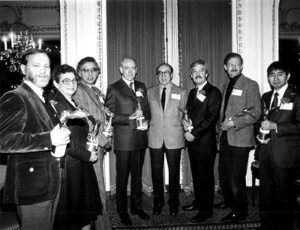
Left to right: J. Michael Bishop, Elizabeth Neufeld, Robert Gallo, Roscoe Brady, Michael DeBakey, Raymond Erikson, Harold Varmus, Hidesaburo Hanafusa
Elizabeth Neufeld is a biochemist and a geneticist. She received the 1982 Albert Lasker Clinical Medical Research Award for her pioneering work that contributed to our basic knowledge of lysosomal storage diseases, the best known of which are Hunter and Hurler syndromes. Neufeld led the University of California, Los Angeles Department of Biological Chemistry from 1984 to 2004. She was chief of the NIH Section of Human Biochemical Genetics, chief of the Genetics and Biochemistry Branch of the National Institute of Arthritis, Diabetes, and Digestive and Kidney Diseases (NIADDK), and deputy director of NIADDK’s Division of Intramural Research from 1981 to 1983. In 1977, Neufeld became the first woman scientist at NIH to be elected to the National Academy of Sciences.
Q: You began your research career in the late ‘40s, early ‘50s, when not many women were joining academia. What prompted you to choose research as a career path?
A: Initially, I didn’t sign up for research; I signed up for working in a lab. I didn’t have the slightest idea what research was. It’s only later when I worked with [Nathan] Kaplan and [Sidney] Colowick, who were famous biochemists, and it was a big deal to be working with them, that I began to do research and discovered that I really loved it. It was exciting and interesting.
Q: What was it like to be a woman in a lab in those days for you?
A: I really didn’t appreciate the problem of being a woman in the lab, that there was a difference. But after I worked for a year with Kaplan and Colowick, I asked Kaplan if I could do my PhD with him, and he seemed quite interested. But the next day he came hopping from one foot to the other saying “Well, you know it’s not so good for women; they’re not interested in science.” That’s when I realized that there was a problem there.
Q: How did things change over the years for you as a woman scientist?
A: One example is that when Fredrickson was the head of NIH [US National Institutes of Health], he said that women were to serve on study sections. That’s very important because if a woman is going to evaluate your grant, you better be polite to her. I think that made a huge difference. Also some people were trying to be fair, and so it got better for women. The issues didn’t go away completely, but they became much less prominent.
Q: Do you have any advice for young women scientists today?
A: Be the best you can be. Whether you’re male or female — that should not enter into it. It’s very tough today to enter the scientific world and to get grant funds. It certainly was easier for young scientists 20 years ago. Today the competition is fierce, the funds are tight, and the only way you can do something is by being extremely good at what you do. That’s my advice, and it applies to everybody.
Q: You came to the United States as a Russian immigrant born in Paris. Did you ever feel that this posed an additional challenge for you in your research career?
A: Being a child of Russian refugees in France right before World War II was not good. When we came to the States in 1940, everybody was trying to escape from Nazi Germany. There were lots of people with Russian background and all kinds of other backgrounds. In the United States, at the time, the issue [of being an immigrant] didn’t exist for me. I thought it was wonderful. I felt much more welcomed here.
Q: How did getting a Lasker Award affect your career, and what did it mean to you?
A: Getting a Lasker Award was a great honor. It certainly gives one more self-confidence. It meant that the outside world saw that what I did was scientifically important and it would become medically important. Today people are being treated in a way that was predicted by my experiments that were mainly done in the 1970s.
